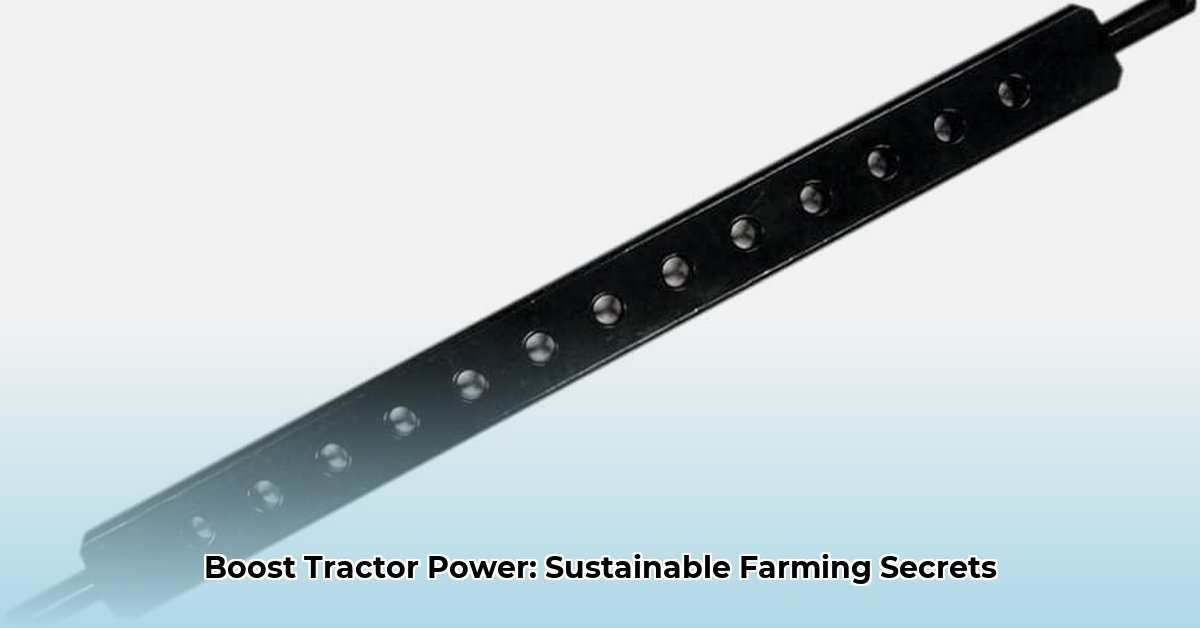
Drawbar for Tractor: Boosting Efficiency in Sustainable Farming
Modern farming demands efficiency and sustainability. While often overlooked, the tractor drawbar—the connection between your tractor and implements—plays a crucial role. Understanding and optimizing your drawbar system can significantly impact fuel consumption, soil health, and overall farm productivity. This article explores different drawbar types, focusing on the advantages of adaptive hitches for enhancing sustainable farming practices. For more on tractor components, see tractor brakes.
Understanding Your Tractor's Hitch: More Than Meets the Eye
Your tractor's drawbar is its connection point for implements, impacting everything from fuel efficiency to soil compaction. Choosing the right drawbar is crucial for optimizing your operation. However, not all drawbars are created equal.
Types of Tractor Drawbars: Simple to Sophisticated
Two primary drawbar types exist: conventional and adaptive. Conventional drawbars are simple, fixed-position hitches, offering reliability and low cost but limited adjustability. Adaptive drawbars, often called three-point hitches, offer adjustable height and angle, leading to improved efficiency and reduced soil compaction.
| Drawbar Type | Description | Advantages | Disadvantages |
|---|---|---|---|
| Conventional | Simple, fixed-position hitch. Easy to use and maintain. | Low cost, simple maintenance, reliable for basic tasks on even terrain. | Limited adjustability, less efficient on varied terrain, may increase soil compaction. |
| Adaptive/Three-Point | Adjustable height and angle. Provides greater control and precision. | Improved efficiency, reduced soil compaction, precise implement control, better for varied terrain. | Higher initial cost, more complex maintenance, requires more operator training. |
Adaptive Hitch Technology: A Smarter Way to Farm
Adaptive hitches offer significant advantages in sustainable agriculture. Their ability to adjust to varying terrain minimizes soil compaction, leading to improved water infiltration, stronger root growth, and higher yields. Reduced compaction also translates to lower fuel consumption. Furthermore, some adaptive hitches integrate with precision farming technologies, optimizing implement depth and speed using sensor and GPS data. Isn't it remarkable how this seemingly simple component contributes to such significant gains?
Making the Switch: A Practical Guide for Farmers
Upgrading to an adaptive hitch involves several steps:
Needs Assessment: Evaluate your farming operation. What implements do you use? What are your biggest challenges? This will help determine if an upgrade is justified.
Budgeting: Develop a budget encompassing the hitch, installation, maintenance, and potential staff training. Explore financing options.
Warranty and Service: Ensure a robust warranty and readily available service and parts.
Rental Option: Consider renting before buying to test performance in your environment.
Training: Ensure thorough training for you and your staff on safe and effective usage.
The Future of Tractor Drawbars: Precision and Data Integration
Future drawbar technology will likely see increased integration with GPS, soil sensors, and other data sources. Imagine a system automatically adjusting based on real-time soil conditions—a future of precision and efficiency. However, challenges remain, specifically standardization across manufacturers for seamless data exchange.
How to Choose the Best Adaptive Hitch for Sustainable Farming Practices
Choosing the right adaptive hitch requires careful planning.
Assess Farm Topography: Map your fields to identify slopes and challenging areas.
Identify Implement Needs: List your implements, considering their weight and size to determine the required lifting capacity and range of movement.
Research Manufacturers: Explore options, considering reputations and warranties.
Get Quotes and Compare: Obtain quotes from multiple vendors, factoring in installation and service costs.
Consider Financing: Explore financing plans and potential government subsidies.
Factor in Maintenance: Higher-end systems may require more frequent maintenance.
Trial Runs: If possible, conduct trial runs to test performance in your specific field conditions.
Pros and Cons of Adaptive Hitches
| Feature | Pros | Cons |
|---|---|---|
| Soil Compaction | Significantly reduced, preserving soil health. | Higher initial investment cost. |
| Fuel Efficiency | Optimized implement performance leads to improved fuel economy. | Requires specialized training for optimal operation. |
| Precision | Enhanced precision reduces input usage (fertilizers, pesticides). | Potential for complex technical issues requiring specialized expertise. |
| Adaptability | Superior performance on uneven terrain. | Complex adjustment mechanisms may slightly slow down operations. |
Future Trends in Adaptive Hitch Technology
Future innovations will likely focus on integrated sensing systems and improved data management. Imagine a hitch automatically adapting based on real-time soil analysis—maximizing effectiveness and furthering sustainable practices.
Key Takeaways:
- Modern tractor drawbar technology significantly enhances farm efficiency and environmental sustainability.
- Adaptive hitches minimize soil compaction and maximize fuel efficiency, particularly beneficial on uneven terrain.
- Careful consideration of costs, maintenance, and integration with existing infrastructure is paramount for successful implementation.